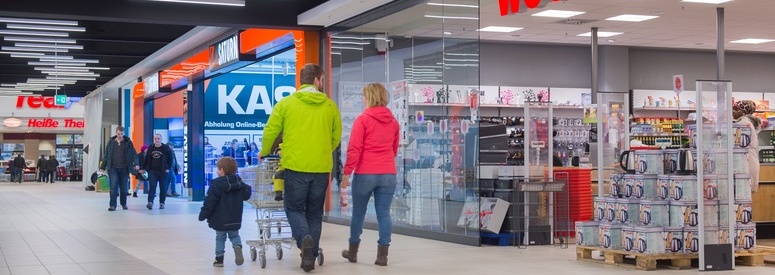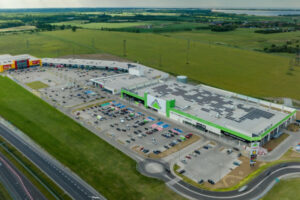By Moritz Felix Lück

There is a ghost roaming in Europe (and around the world) – the ghost of digitization. The postive and negative transfiguration of technology is as old as mankind. The corresponding buzzword of our time is digitization.
Is digitization the unstoppable, all-changing and all-destroying savior or annihilator, as it is often depicted to be, or must we assess it differently? What does it mean for our world of retail properties and for those industries that are existentially linked to retail properties?
Digitization prosaically explains that digital technologies can impact economic life sustainably – but they don’t have to. Because the often at least indirect allegation that every new digital technology will be embraced by users and revolutionize everything, is wrong.
Just because something is technically possible or can be done in a technology-based way, does not yet mean that it will be successful.
A simple example from the retail property sector: Theoretically, asset and property managers can exchange their data independenty of any system with enterprise resource planning systems like SAP. Oftentimes this does not work because, for example, IT-security guidelines prohibit the programming of an interface. Collaboration between different IT-systems would make cooperation much simpler. In many cases, however, it remains a theoretical possibility for technical reasons.
Nevertheless, there are many things in motion in the retail and retail property sector – and that’s a good thing because that facilitates change. In any concrete situation it is almost always necessary to find out which new solutions or technologies can improve a business model or processes by launching test and pilot projects. The increasing openness towards this learning-oriented approach alone is already a benefit for which we have to thank digitization. The key influences digitization has on various applications in the retail park and hybrid mall segment can be summarized with five core theses:
- Digitization is useless for retail without tackling unterlying issues like strict customer orientation and positioning
Online retail triggered comprehensive change processes in the retail sector. A still consistent core problem of many retailers is that basic, customer-oriented issues are not approached at all or not extensively enough. In times of hypercompetition of brands and retail concepts it becomes increasingly important that customers and their wishes are the focus of all (retail-related) activities. If customers do not immediately and distinctively recognize what a retail company stands for (positioning), this retailer becomes interchangeable and, when in doubt, will only by measured by pricing.
But there are also examples for successful reorientations. The Germany food retail industry has reinvented itself noticeably and fundamentally for its customers over the last years. New sales concepts, new product ranges, new shop fitting – the full-range suppliers were able to put pressure on discounters and the discounters stepped up their game. Active positioning, readjustment of brands, integrated and customer-oriented presences do pay off.
Retailers with aperiodic demand can follow this strategy. If they don’t do it they have to face imbalances and they could already be in trouble today. Insolvencies in the textile industry show how important it is to comprehensively adapt to the enormous competitive pressure with customer-focused management.
Betting on multichannel alone, however, will not be enough. Even sophisticated multichannel strategies cannot iron out structural deficiencies of the above-mentioned kind. The problems of the stuck-in-the-middle retailers, which were already analyzed multiple times, will otherwise not be solved with online strategies but only expanded into the online business. Retail companies that act fast and goal-oriented have the opportunity to secure competitive advantages. Those who hesitate too long risk falling victim to market shakeouts.
Today’s market power lies in the hands of consumers; demand determines supply. This is why retail’s focus on distribution becomes less important while insights about consumers and their wishes become essential. Retailers and the operators of retail properties need customer-related know-how, particularly for areas that are subject to trends, fashions, and changing lifestyles.
Permanent connectivity, high price sensitivity, and purchasing motives that go beyond the respective product and aim for immaterial added value are the reasons why customer-oriented retail concepts are necessary. This profound, demand-driven structural change significantly impacts the retail sector, its locations, and retail property concepts.
Making life more comfortable, more simple, and richer (in an immaterial sense) is an essential benefit, which customers expect from retail today. Today, a “good selection” includes creating product worlds, combining product ranges and creating solutions for everyday use. It is a thin line between complexity and confusion, simplicity and disappointment.
Physical marketplaces in vibrant environments provide better conditions for a good and inspiring shopping atmosphere. Successful marketplaces score points with the partnership-oriented coexistence of retaiers and suppliers who ultimately offer a wider variety than lone fighters, particularly in market segements that are not dominated by supplier oligopolies. Therefore locations that consist of partnership-oriented competitors in a compact and attractive environment are of increasing importance for retail stores. This trend moves towards bigger, more varied shopping experiences which happen less frequently and therefore are done at fewer locations.
Therefore it is all the more important for retailers to be present at the right locations to seize all opportunities. Due to this development, retail parks, hybrid malls, and local supply centers are becoming sophisticated management opportunities to turn locations into marketplaces.

- Digitization is mostly an evolution, and not a revolution
Digitization has been accompanying business and society since the introduction of IT in the workplace. Today’s most common meaning of digitization stands for potential business models and processes that can be realized due to permanent connectivity and data processing. This perception has more of an indirect impact on the asset class of retail parks because digitization or online retail take the retail sector to a new stage of development. The corresponding buzzwords are multichannel and omnichannel. However, as I said before, technology cannot compensate for structural deficiencies of retail concepts.
The development of the online retail sector will not replace stationary retail. There will be, however, substantial shifts in revenue, depending on the respective industry, which will have an impact on sales models, space requirements, customer behavior, etc. This reinforces a trend that has been developing over the last years: to make retail parks more flexible when they are up for modernization and revitalization, for example when it comes to floor layouts and operating technology.
Digital technology, for example in the form of smart metering is already used today to reduce ancillary costs. The biggest opportunities for digitization may actually be found more in the field of B2B applications. Truly revolutionary, however, is building information modelling (BIM), as it fundamentally changes construction planning and building processes. Germany may be a bit slower than other countries to accept BIM but it is only a question of time until it becomes the standard there as well. The cost reductions resulting from BIM apply to all property classes. It is a comprehensive revolution in that respect, among the many evolutionary developments.
- Investors and operators have to increase their support of retailers
The omissions of the retail industry must not result in investors and operators taking it too easy. The goal is to support retailers in their stores with smart measures. Digital technology can help with that. Many approaches and experiments already exist, a one-size-fits-all solution, however, doesn’t. Everybody has to find out by themselves whether it really makes sense to develop center apps and therefore compete with retailers. Maybe it is more helpful and expedient to equip the asset class of retail parks with the kind of technology that supports the respective retailers’ communication and sales promotion measures.
Extensive Wi-Fi networks (or their technological successors) give retailers the opportunity to contact users with the respective retailer’s app on site and generate sales. It increases customer retention for the retailers, supports the brand and therefore also helps the retail property. Other approaches for active sales promotion, that can be provided for retailers by investors and operators, are currently being developed to market maturity.
One of the core issues is information processing on various levels, including via retailers / tenants and property owners. A concrete example is the question which approaches can be used to set up, control, and manage the respective retail property efficiently (for example, regarding air conditioning and lighting). Another issue for asset management is purchase stream analysis to sustainably optimize and upgrade specific areas of the center and help with space letting.
- Construction and planning regulations will have to meet retail’s requirements for digitization
In reference to Bloch’s phrase “the simultaneity of the non-simultaneous”, one could call the challenge to adapt construction and planning regulations for the digitization of retail “the space-relatedness of the spaceless”. It takes a lot of rethinking to apply the impact of online retail to the formulation and application of German planning regulations. A virtual dimension impacts real spaces and retail’s reactions to virtual dimensions must be reflected in its adjustments of product ranges and sizes. They are, however, restricted by the duration of planning and approval processes.
Especially in rural areas, retail reacts to declining demands with an expansion of its product offering. This may require more space and new limits to the respective product range. It is vitally important to individually evaluate in every single case what the kind of impact revenues that shifted to the internet have on this development. Therefore it is not about undermining the central-place system, but adapting it for the future and ensure its viability.
Online retail has to be taken into account more extensively, not only when it comes to competition aspects. Especially in rural areas, it is necessary to slow down the migration to the cities with adapted retail locations. The challenge to keep rural areas attractive is immense, and retail locations are an important aspect of attractive residential areas. Retail policies are turning more and more into retail policies. They are an important part for the creation of equal living conditions in all regions.

- The digitization industry teaches valuable method knowledge
The way digitization companies work provides a myriad of learning opportunities. Companies like Google or Amazon are strictly customer-oriented and competitive. Amazon’s mission is to be world’s most customer-oriented company. Understanding wishes of customers is essential for survival in times of hypercompetition; this cannot be repeated often enough.
This kind of orientation can only be achieved when companies develop a constructive culture of openness, accepting mistakes and working with trial & error. After all, the only way to find out if one really recognized and met customers’ demands is, if one gives solutions a try and is willing to learn from (partial) rejection. This is necessary due to the speed of change, the oftentimes existing lack of direction during transformation processes (what will work and when, etc.), and the increasing pressure to attend (or not attend) to the interests of specific groups. In short: as a constant companion of business models and processes, one has to categorically accept a certain lack of direction. This world was never known for its certitude.
If one accepts this and prepares oneself for it as an organization, one can seize many opportunities, which arise due to the pressure of change, faster and more expediently. Being willing to accept mistakes and learn from them, trial & error, and accepting risks can be real strengths. After all, in times of comprehensive and long-lasting changes, one thing remains true: Everything stays different.
About the market report





